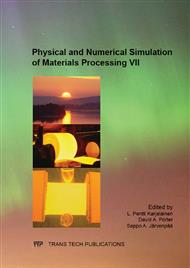p.686
p.691
p.699
p.705
p.711
p.717
p.722
p.728
p.734
Physical Simulation for Evaluating Heat-Affected Zone Toughness of High and Ultra-High Strength Steels
Abstract:
Physical simulation of the most critical sub-zones of the heat-affected zone is a useful tool for the evaluation of the toughness of welded joints in high-strength and ultra-high-strength steels. In two high-strength offshore steels with the yield strength of 500 MPa, the coarse grained, intercritical and intercritically reheated coarse grained zones were simulated using the cooling times from 800 to 500 °C (t8/5) 5 s and 30 s. Impact and CTOD tests as well as microstructural investigations were carried out in order to evaluate the weldability of the steels without the need for expensive welding tests. The test results showed that the intercritically reheated coarse grained zone with the longer cooling time t8/5=30 s was the most critical sub-zone in the HAZ due to the M-A constituents and coarse ferritic-bainitic microstructure. In 6 mm thick ultra-high-strength steel Optim 960 QC, the coarse grained and intercritically reheated coarse grained zones were simulated using the cooling times t8/5 of 5, 10, 15 and 20s and the intercritical zone using the cooling times t8/5 of 5 and 10 s in order to select the suitable heat input for welding. The impact test results from the simulated zones fulfilled the impact energy requirement of 14 J (5x10 mm specimen) at -40 °C for the cooling times, t8/5, from 5 to 15 s, which correspond to the heat input range 0.4-0.7 kJ/mm (for a 6 mm thickness).
Info:
Periodical:
Pages:
711-716
Citation:
Online since:
July 2013
Keywords:
Price:
Сopyright:
© 2013 Trans Tech Publications Ltd. All Rights Reserved
Share:
Citation:


